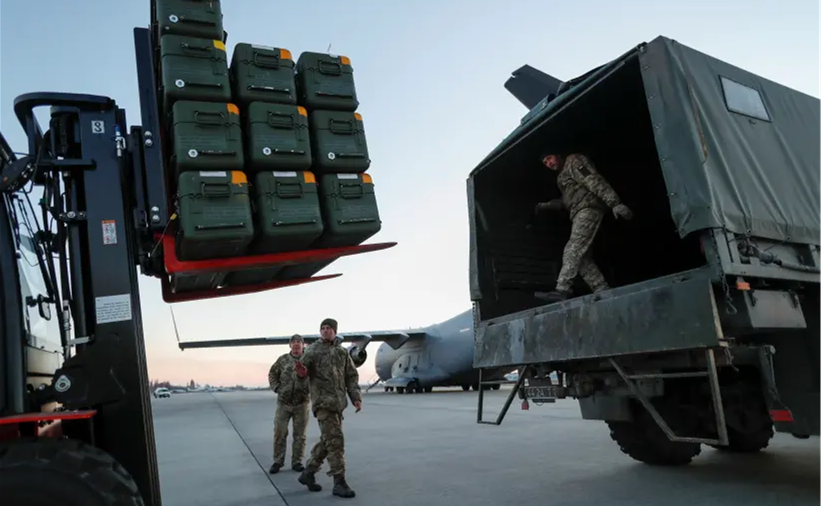$17 billion could buy a lot of food aid.
The first point that needs to be made in addressing the colossal $40 billion Ukraine arms aid package passed by Congress and rushed by plane to Asia for President Joe Biden’s signature is that it’s not all for weapons.
The package, which was approved with little discussion by lopsided votes of 368-37 in the House and 86-11 in the Senate (with only Republicans voting against it in either chamber), is huge any way you look at it. But that said, only $17 billion is for actual weapons (and training) going to Ukrainian military forces.
The rest of the money is either a sleight-of-hand $9 billion for arms makers to buy replacement weapons for those “drawn down” from U.S. military stockpiles (which is actually double-counting the $11 billion paid to the Pentagon for the transfer of those stockpiles to Ukraine), $4 billion for European Command Operations (NATO headquarters costs), $1 billion to defray the costs to Ukraine and other nations of handling some 6 million refugees fleeing the fighting, and another $9 million for economic aid to war-impacted countries.
Still, even $17 billion buys a hell of a lot of destructive and deadly weaponry.
Let’s put it in some kind of context — something that the largely cheerleading pro-war U.S. media have not been doing with this particular war.
In 2021, Germany’s entire military budget was $47 billion and Russia’s, during the year before it launched its war against Ukraine, was $66 billion. That is to say the U.S. — which also gave Ukraine $4.6 billion in lethal aid before passing the so-called Emergency Ukraine Arms Aid bill, bringing the total in military aid given over a four-month period to $21 billion — has reached a military spending total roughly half the size of Germany’s entire 2021 military budget, and a third of Russia’s!
Now Ukraine has an official 2022 population of just under 44 million (2.5 million of whom have reportedly fled the country this year to more peaceful nations), while Russia’s population is 146 million. Ukraine’s 2020 GDP, the entire economic activity of the country, was $156 billion, compared to Russia’s $1.5 trillion that same year.
The U.S. military budget in 2021 was $753 billion, while U.S. GDP that year was $23 trillion.
In other words, the U.S. military budget in 2021 represented 3.1% of GDP, while the $17 billion of arms being dispatched to Ukraine represents almost 11% of Ukraine’s 2021 GDP. This is particularly dramatic when one notes that in 2021, Ukraine’s entire military budget was $6 billion, a third of what it is getting from the U.S. over a four-month period this spring!
What is likely to happen with all this materiel and lavish funding?
In the best of circumstances, it will likely increase corruption. How does a military of 250,000 regular troops take on board $17 billion worth of advanced equipment, including planes, anti-tank weapons, and guided missiles? And how, in a nation notorious for its level of corruption, does Washington prevent the black-market transfer of the valuable equipment Ukraine is receiving? All manner of foreign agencies, from terrorist organizations to rival nations of the U.S. like Iran, North Korea, China and even Russia, would like to get their hands on such equipment, either to copy the technology or use it against U.S. forces at some future date.
No wonder Sen. Rand Paul (R-KY) tried — ultimately unsuccessfully — to have language added to the aid bill establishing a dedicated inspector general to monitor spending and track where all the weapons went.
Sen. Paul’s effort failed, with Republicans and Democrats alike pushing ahead to pass the bill and get it signed.
Among the goodies in this massive weapons package headed for Ukraine are Mobility Artillery Rocket Systems, which have a controversial long range that could allow them to strike targets inside of Russia; five counter-artillery radars designed to help Ukrainian forces locate and attack Russian artillery; 1,000 more Javelin anti-tank guided missiles and the command launch units that fire and guide them to targets; and 90 M777 Howitzer long-range cannons along with 15,000 rounds of 155 mm ammunition for them.
Russian troops are making a slow advance westward from the Donetsk and Luhansk oblasts, while Ukrainian forces make small gains in urban areas, pushing Russian forces back. Whether this massive influx of state-of-the-art U.S. weaponry will turn the tide of this grinding war in Ukraine or prove ineffective remains to be seen.
Meanwhile the spectacle of Uncle Sam lavishing aid on Ukraine in amounts close to half of what it spends globally per year in humanitarian aid has the world’s poorer nations in a growing uproar. That anger is stoked by the impact of U.S. sanctions on Russian oil and gas, which have raised the costs of energy and fertilizer in struggling developing nations.
As Lula, the former Brazilian president — and one of Brazil’s most popular political figures, who is likely to sweep back into office in the upcoming presidential election this October — said at a speech on a campaign tour in the Brazilian state of Rio Grande do Sul, “It is not possible that President Biden, who never made a speech to give a dollar for those who are dying of hunger in Africa, announces $40 billion to help Ukraine buy weapons; it is not possible.”
Image by Valentyn Ogirenko / Reuters

